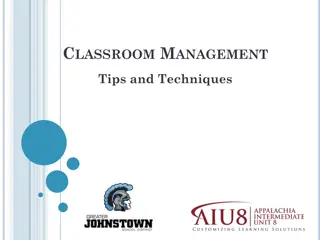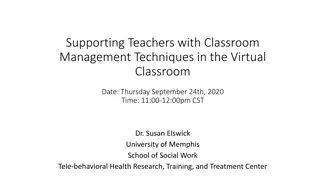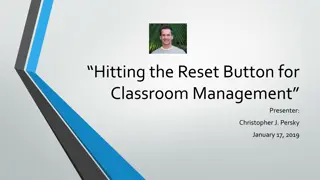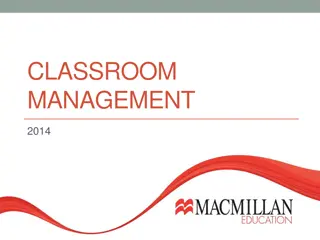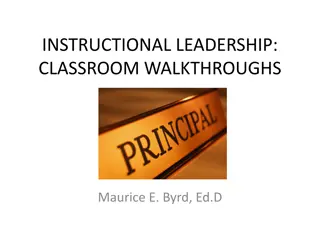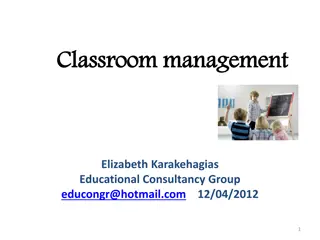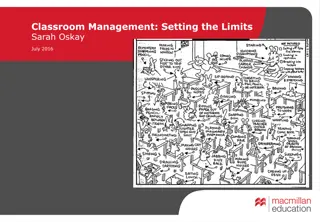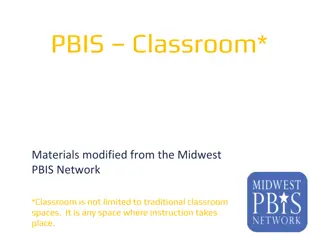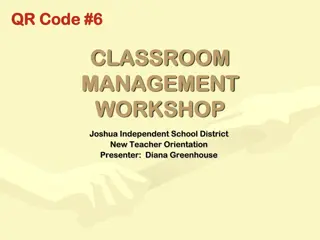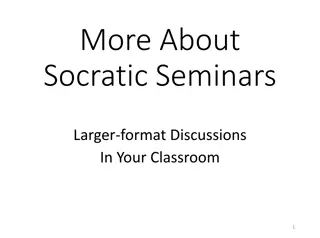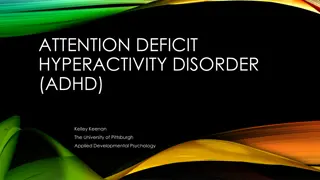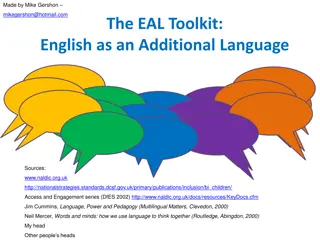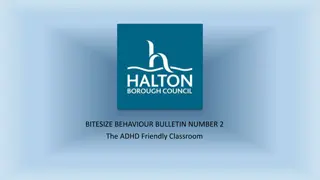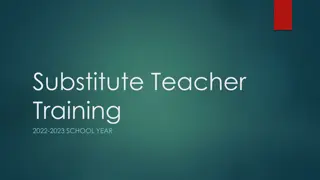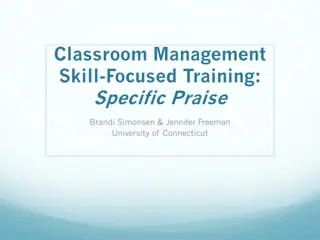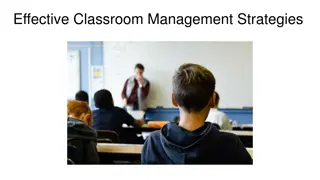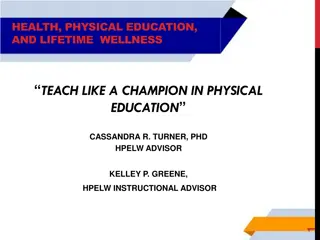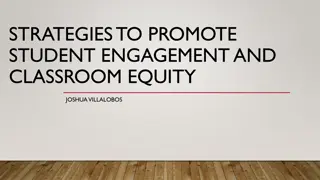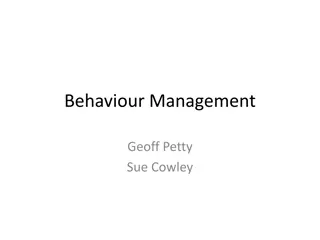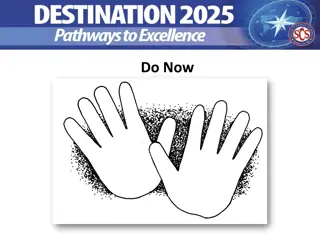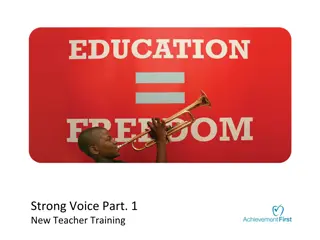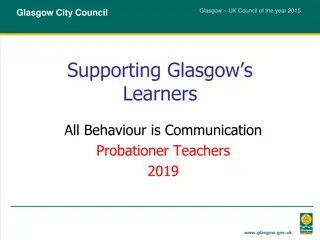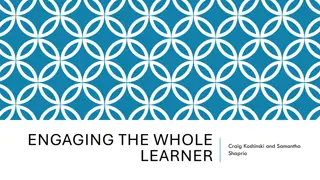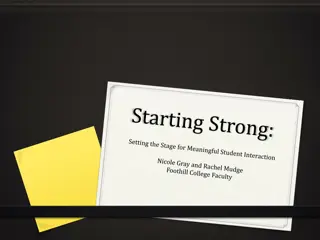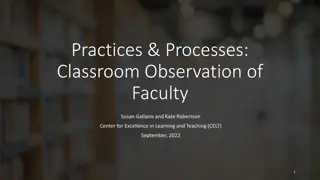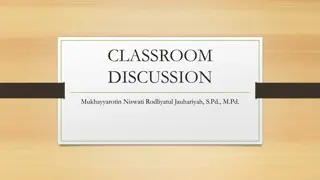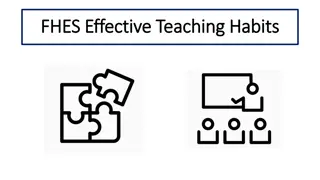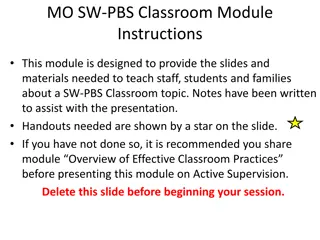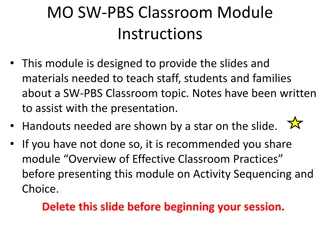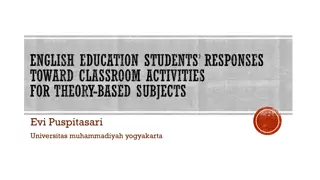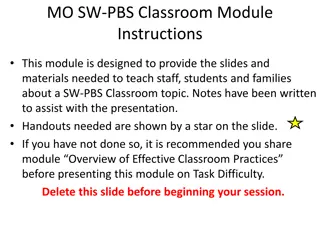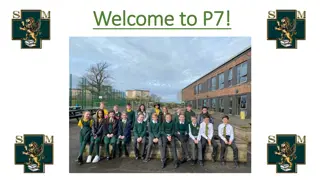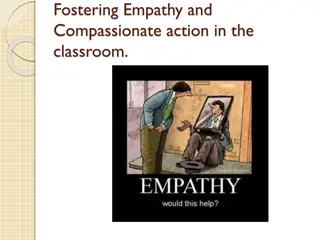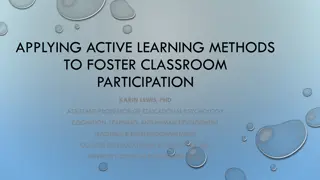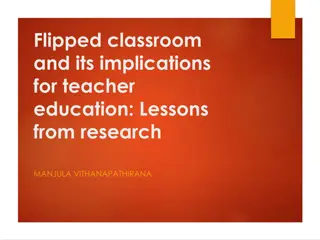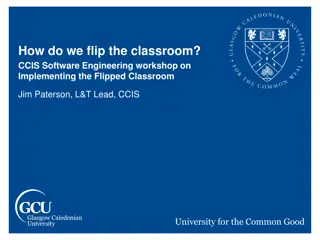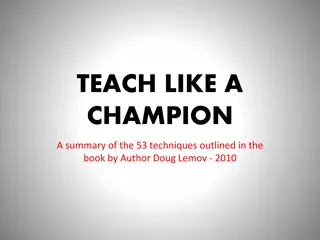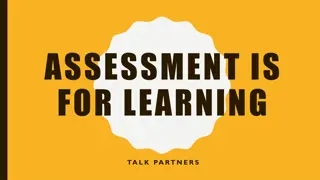Effective Classroom Management Techniques and Strategies
Explore the essential aspects of classroom management, including communication, feedback, handling mistakes, lesson objectives, techniques for managing behavior, and dealing with challenging behaviors. Understand the importance of creating a positive learning environment, developing effective teaching practices, and fostering a reflective approach towards teaching. Gain insights into addressing disaffection, disengagement, and disruption in the classroom through practical activities and discussions.
- Classroom Management
- Teaching Strategies
- Behavior Management
- Effective Communication
- Student Engagement
Uploaded on Oct 05, 2024 | 0 Views
Download Presentation

Please find below an Image/Link to download the presentation.
The content on the website is provided AS IS for your information and personal use only. It may not be sold, licensed, or shared on other websites without obtaining consent from the author. Download presentation by click this link. If you encounter any issues during the download, it is possible that the publisher has removed the file from their server.
E N D
Presentation Transcript
Its okay to make mistakes , but not the same one Even as teachers we need to reflect and think adjust our teaching.
Classroom Management Classroom Management
Lesson objectives Understand classroom management Know how to manage a classroom Discuss issues with classroom management Create a plan for your classroom management
Lesson objectives List 3 classroom management techniques Describe one technique to manage a classroom Discuss issues with classroom management Create a plan for your classroom management
What is Classroom Management? What is Classroom Management? Classroom management is about: 1. Learning the techniques required to control behaviour 2. Understanding the factors that make up a positive academic climate 3. Developing effective teaching practices to keep learners interested and engaged. 4. Adopting a reflective and empathetic attitude towards learners and the learning process Tully (2011)
Dealing with the 3 Ds Dealing with the 3 Ds Disaffection Disengagement Disruption
Activity 1 Activity 1 What are the behaviours we find challenging? What are the behaviours we find challenging? 5 mins In your groups use the one half of the sheet on your desk to list the behaviours we find challenging. Group feedback
Activity 2 Activity 2 What are the reasons for these behaviours? What are the reasons for these behaviours? 5 mins In your groups list these on the other half of the sheet of paper on your desk. Group feedback.
Examples Examples Forgetting resources ie USB stick apply a negative consequence write out materials and redo them electronically later. Using phone think creatively 20mins task completion 2 mins phone use. Phones out on table in view. This topic is boring for a dry topic make the learning process more engaging Late to class negative consequence you choose where they sit, up to them to catch up work missed ask to see
Comparing the Effectiveness of Aspects of Comparing the Effectiveness of Aspects of Classroom Management Classroom Management Summary of Experimental Data from Marzano (2003) Aspect of Classroom Management Average effect size No of Students Decrease in Number of Disruptions Rules & Procedures 0.76 626 28% Teacher-Student Relationship 0.87 1110 31% Disciplinary Interventions 0.91 3322 32% Mental Set 1.3 502 40% An effect size of 0.5 gives a one-grade leap. An effect size of 1.0 gives a two-grade leap.
Rights & Rules Rights & Rules Rights The Teacher has a right to: The Student has a right to: Teach without hindrance Expect good quality teaching Feel safe Be treated fairly Be listened to Be listened to Be treated with respect Be treated with respect
Activity 3 Activity 3 Setting Boundaries (Rules) Setting Boundaries (Rules) 10 mins In your groups make a list of your golden rules?
Suggested Activities with Students Around Suggested Activities with Students Around Setting Boundaries Setting Boundaries Activity 1 What to do and when to do it! Class College Home Mates Work G/B Friend Nan Sing Swear Phone Kiss Shout Spit Laugh
Suggested Activities with Students Suggested Activities with Students Activity 2 To get students to think about which behaviours give them the best chance of succeeding on their course, ask them to generate the 5 habits of successful students 1. Pair teams up and ask them to reduce their lists to the top five habits 2. Put the lists from the different groups on the board 3. Ask the class to vote off characteristics until only 5 are left 4. Print these up and display them in the classroom
Consequences (Not Punishments) Consequences (Not Punishments) Agree the consequences!!! Carry out the consequences!!! Notes these are consequences of their behaviour not threats or punishments!
Activity 4 Activity 4 Best Consequences Best Consequences 5 mins In groups list some suitable consequences to come of the previously identified behaviours
The Ideal Teacher The Ideal Teacher- -Student Relationship Student Relationship Dominant Strong sense of purpose in pursuing clear goals for learning and for class management. Leadership. Tends to guide and control Prepared to discipline unapologetically Too dominant Too controlling Lack of concern for students Teacher student relations damaged Ideal teacher- student relationship Opposition Cooperative Treats students as the enemy Expresses anger and irritation Need to win if there is a disagreement between teacher and students Great concern for the needs and opinions of students. Helpful, friendly Avoids strife and seeks consensus Too cooperative Too understanding and accepting of apologies Waits for students to be ready Too desirous to be accepted by students Submission Lack of clarity of purpose Keeps a low profile Tendency to submit to the will of the class Entirely unassertive, rather glum and apologetic
What do Students Need from Teachers? What do Students Need from Teachers? The first four weeks continuity Group Feedback Work ethic Diagnosis not just literacy/numeracy levels, understand how they learn Support base room to go to for support Value learn their names quickly Requests for tasks/materials Confidence in staff
First Day Tips First Day Tips 1. Greet students at the door. 2. Establish name identification through the use of nametags, introductions or taking registers. 3. Introduce students to the room arrangement and classroom procedures. 4. Introduce three to six classroom rules, explain and post them. 5. Plan for maximum contact with students. 6. Establish yourself as a leader of the class. 7. Learn students' names as soon as possible.
Improving Disciplinary Interventions Improving Disciplinary Interventions Disciplinary interventions Effect size Decrease in number of disruptions Reminders of rules 0.64 24% Mild punishments ( Sticks ) 0.78 28% Strategies that reward appropriate behaviour ( Carrots ) 0.86 31% Carrots plus sticks 0.97 33% An effect size of 0.5 gives a one-grade leap. An effect size of 1.0 gives a two-grade leap.
Activity 5 Activity 5 Examples of carrots Examples of carrots 5 mins In your groups list some suitable ways you can offer carrots strategies to reinforce appropriate behaviour
Levels of Intervention (sticks) Levels of Intervention ( sticks ) Level 1 behaviour The 5 second pause The 10 second funny quip The 20 second intervention point out what you want, not what you don t want Level 2 behaviour The Yes Set - 3 truths ie you re here, you have your pen, you re having a discussion now answer the task 1 minute intervention Choice and consequence Level 3 behaviour Emergency stop Set outside The Hot Spot Please note do not rush to this stage! Good classroom management means you never get here! Finally Point out the boundaries list Give one last warning Apply the sanction
Actions Speak Louder than Words Actions Speak Louder than Words Rapport and breaking rapport sitting within chatting groups ignore them, give positive reinforcement to rest of class, reminder of what everyone should be doing. Body space Body language Yes Sets 3 truths ie you re here, you have your pen, you re having a discussion now answer the task. Hot Spots
Mental Set Mental Set Withitness heightened awareness of what is going on in your classroom and responding very quickly 1. Scanning 2. Intervene promptly 3. Use names 4. Stop instruction 5. Use non-verbal reminders and commands 6. Avoidance 7. Reminders & warnings 8. Walk around Emotional objectivity keeping an emotional distance between you and classroom events, and thinking about your emotional response to them 1. Don t take the behaviour personally 2. Don t hold grudges
Tips Tips - - Minimising Challenging Behaviour Minimising Challenging Behaviour Interesting and exciting lessons Understanding what your triggers are Having high expectations Setting boundaries Being clear, fair and transparent Use 3 levels of intervention Applying consequences Manage your state and response Think about your use of language
Activity 6 Activity 6 GROUP WORK (approx 10mins) Produce your own top tips
Effect on Good Behaviour on Student Effect on Good Behaviour on Student Achievement Achievement Number of studies 361 Hattie and Marzano s Effect sizes Effect size Classroom behaviour The influence of appropriate student behaviour on achievement 0.71 Marzano: Effect of experimenting with improved classroom management techniques on student achievement 0.52 134 An effect size of 0.5 gives a one-grade leap. An effect size of 1.0 gives a two-grade leap.
Keep Calm & Carry on! Keep Calm & Carry on! Pay attention to all your small victories and build on them. Notice what doesn t work, resolve to leave it behind and move on. Tomorrow is another day and the good thing about students is they are never the same as the day before because they are learning! Don t hold their behaviour today against them tomorrow. Those things your students value your time, attention, fairness, compassion and humour are yours to give and are renewable resources after a good nights sleep!
Useful resources Chapter 8 p96-107 Petty, G. (2004) Teaching Today 3rd edition. Cheltenham: Nelson Thornes http://geoffpetty.com/geoffs- books/downloads-for-ebt/ Geoff Petty [online] chapter 26 on classroom management and discipline



